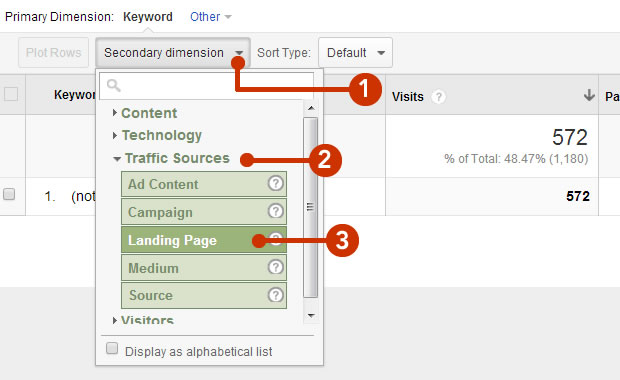Understanding Secondary Dimension in Google Analytics: A Full Overview
Understanding Secondary Dimension in Google Analytics: A Full Overview
Blog Article
Take Full Advantage Of Coverage Accuracy With Additional Dimension in Google Analytics
Recognizing how to optimize reporting precision with second measurements in Google Analytics can significantly boost the depth of understandings acquired from data evaluation. By integrating secondary dimensions tactically, marketing experts can discover surprise patterns and correlations that might not be instantly evident when examining primary metrics alone. This nuanced technique enables an extra extensive understanding of user behavior and project performance, paving the method for more targeted and reliable decision-making. The usage of secondary measurements holds the crucial to opening a wide range of important info that can change the performance of digital marketing methods.
Understanding Second Dimensions in Google Analytics
Secondary measurements enable customers to sector and even more explore data beyond the primary measurement chosen. While the key dimension might show the total number of web page sights, adding an additional measurement such as 'source/medium' can give understandings right into where the web traffic stemmed from.
Moreover, comprehending secondary dimensions is critical for producing much more customized reports customized to specific company goals. By choosing the best mix of key and secondary dimensions, experts can uncover patterns, trends, and connections that may otherwise continue to be surprise. This nuanced method to data evaluation empowers services to make enlightened decisions based upon a thorough understanding of user habits throughout different dimensions.

Just How to Apply Second Dimensions
When leveraging additional measurements in Google Analytics, the functional application entails picking particular data parameters to additional improve insights beyond the primary dimension's range. To apply additional dimensions effectively, begin by accessing the record or dataset where you wish to dive deeper into the data. Within Google Analytics, locate the primary dimension that you are currently evaluating. As soon as determined, click the dropdown food selection classified "Second Dimension." This action will certainly disclose a checklist of additional parameters that can be contributed to your evaluation. Pick the second dimension that lines up with your analytical goals, such as 'Source/Medium,' 'Gadget Classification,' or 'Place.' By choosing an additional dimension, you can gain much more detailed understandings into customer actions, demographics, or purchase channels. Keep in mind that second measurements aid provide context and granularity to your primary measurement data, enabling you to remove more actionable and significant understandings from your Google Analytics records.
Leveraging Second Measurements for Insights
Using secondary measurements in Google Analytics permits for an extra thorough evaluation of information, using valuable understandings beyond the primary dimension's range. By leveraging second dimensions, customers can dig deeper into the performance metrics of their site or application, discovering surprise patterns and trends that may not be quickly noticeable when just looking at primary measurements.
One trick benefit Get More Information of using second dimensions is the capacity to segment and filter data a lot more exactly. This can aid marketing experts and experts better recognize the behavior of certain customer segments, such as new visitors versus returning site visitors, or traffic coming from different geographical locations.
Moreover, secondary dimensions allow customers to contrast and comparison numerous information factors within the very same record, supplying a more alternative sight of performance (Secondary Dimension in Google Analytics). Pairing the key dimension of landing web pages with second measurements like demographics or gadgets can expose which web pages are most efficient in engaging individuals on different gadgets or from different group groups.
Basically, leveraging additional measurements in Google Analytics empowers customers to extract richer understandings from their information, resulting in even more enlightened decision-making and eventually, boosted performance.
Best Practices for Additional Dimensions
When assessing data in Google Analytics, integrating second measurements properly improves the deepness of insights acquired from the key metrics. Choosing appropriate secondary measurements aids in supplying context and a more clear understanding of the information being analyzed.
Additionally, it is suggested you could try here to restrict the variety of second dimensions utilized in a single record to stay clear of overwhelming the analysis with as well much information. Concentrating on a couple of vital secondary dimensions at once can result in more focused and actionable insights. Additionally, take into consideration try out various combinations of key and secondary measurements to discover distinct fads and patterns that might not be evident when considering the information alone.
Advanced Analysis Methods With Secondary Dimensions
Exploring elaborate information partnerships via the strategic application of second dimensions can reveal nuanced insights that elevate the deepness of evaluation in Google Analytics. By combining second measurements with primary information sets, innovative analysis methods can be employed to remove important information.
Furthermore, second dimensions can improve the analysis of conversion courses by supplying additional context. Comprehending the various touchpoints a customer engages with prior to converting can be essential in enhancing the client journey - Secondary Dimension in Google Analytics. By using secondary measurements to explore specifics such as traffic resources or tools More Bonuses utilized, marketing professionals can tailor strategies to target high-converting channels effectively
Conclusion

To enhance data analysis and gain deeper understandings into individual habits, comprehending secondary measurements in Google Analytics is important - Secondary Dimension in Google Analytics. Additional dimensions permit individuals to sector and additionally study information past the primary dimension picked. While the primary dimension may display the complete number of page sights, adding a second measurement such as 'source/medium' can give insights into where the traffic originated from.When leveraging additional measurements in Google Analytics, the sensible application entails picking specific data parameters to further refine insights beyond the key measurement's extent. Bear in mind that second measurements aid supply context and granularity to your main dimension data, enabling you to extract even more purposeful and actionable understandings from your Google Analytics records
Report this page